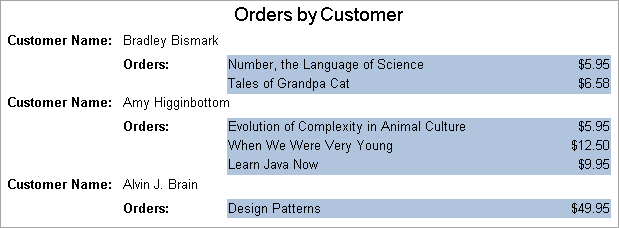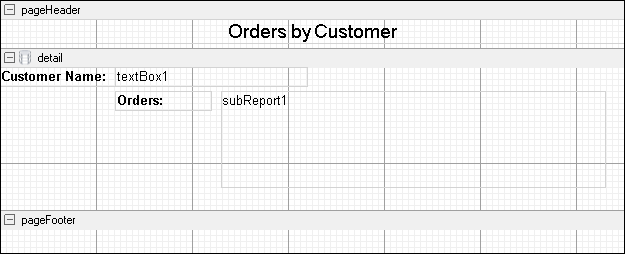- Introduction
- Report Readers
- Report Authors
- DevOps
-
Developers
- Quick Start
- Breaking Changes
- ActiveReports Version Compatibility and Migration
- License ActiveReports
- Configure ActiveReports Using Code
-
Work with Reports using Code
- Visual Studio Integrated Designer
- Page/RDLX Report
-
Section Report
- Create a Report or Load an Existing Report
- Bind a Section Report to Data
- Save Section Reports
- Change Ruler Measurements
- Modify Printer Settings
- Insert or Add Report Pages
- Save and Load RDF Files
- Work with Subreports
- Draw on the Canvas of Rendered Report
- Work with Code-based Section Reports
- Optimize Section Reports
- Custom Properties in Chart
- Report Parts
- Create Designer and Viewer Applications
- Extensibility in ActiveReports
- External Customizations in ActiveReports
- Export Reports
- Print Reports
- Plugins Development
- Samples
- Troubleshooting
Subreports with XML Data
Using XML data requires some setup that is different from other types of data. This walkthrough illustrates how to set up a subreport bound to the XML DataSource in the parent report.
When you complete this walkthrough you get a layout that looks similar to the following.

Create Report
- In Visual Studio, create a new Windows Forms App (.NET Framework) project and click Next.
- In the Configure your new project dialog, type a name for your project, set Framework to .NET Framework 4.7 and click Create.
- From the Project menu, select Add New Item.
- In the Add New Item dialog that appears, select ActiveReports 19 Code-Based Report and in the Name field, rename the file as rptMain.
- Click the Add button to open a new Section Report in the designer.
- From the Project menu, select Add New Item.
- In the Add New Item dialog that appears, select ActiveReports 19 Code-Based Report and in the Name field, rename the file as rptSub.
- Click the Add button to open a second new Section Report in the designer.
Connect the Parent Report (rptMain) to a Data Source
- On the detail section band, click the Data Source Icon.

- In the Report Data Source dialog, on the XML tab, click the ellipsis (...) button next to File URL field.
- In the Open File window that appears, navigate to Customer.xml and click the Open button.
- In the Recordset Pattern field, enter //CUSTOMER.
- Click OK to save the data source and return to the report design surface.
Design Report Layout for the Parent Report (rptMain)
- On the design surface, select the pageHeader section and in the Properties panel, set the Height property to 0.3.
- On the design surface, select the grey area outside the report and in the Properties panel, set the PrintWidth property to 6.5.
- On the design surface, select the detail section and in the Properties panel, set the CanShrink property to True to eliminate white space.
- From the toolbox, drag the Label control onto the pageHeader section and in the Properties panel, set the Text property to 'Orders by Customer'.
- From the toolbox, drag the controls onto the detail section and in the Properties panel, set the properties of each control as follows.
- From the toolbox, drag the following controls onto the detail section and in the Properties panel, set the properties of each control as follows.
- TextBox1
DataField: NAME - Label1
Text: Customer Name: - Label2
Text: Orders: - Subreport
- TextBox1
Design Report Layout for the Child Report (rptSub)
On the design surface, select the detail section and in the Properties panel, set the CanShrink property to 'True' and BackColor to 'LightSteelBlue'.
type=info
Tip: Even if you do not want colors in your finished reports, using background colors on subreports can help in troubleshooting layout issues.
On the design surface, right-click the pageHeader or pageFooter section and select Delete.
type=note
Note: Subreports do not render these sections, so deleting them saves processing time.
From the toolbox, drag the following controls to the detail section and in the Properties panel, set the properties as follows.
Property Name Property Value TextBox1 DataField TITLE Name txtTitle TextBox2 DataField PRICE Name txtPrice OutputFormat $#,##0.00 (or select Currency in the dialog)
Add Code to Create a new instance of the Child Report (rptSub)
type=warning
Warning: Do not create a new instance of the subreport in the Format event. Doing so creates a new subreport each time the section Format code is run, which uses a lot of memory.
VB Code:
- Right-click the design surface of rptMain and select View Code.
- At the top left of the code view of the report, click the drop-down arrow and select (rptMain Events).
- At the top right of the code window, click the drop-down arrow and select ReportStart. This creates an event-handling method for the ReportStart event.
- Add code to the handler to create an instance of rptSub.
The following example shows what the code for the method looks like.
Dim rpt As rptSub
rpt = New rptSub()
C# Code:
- Click in the gray area below rptMain to select it.
- Click the events icon in the Properties panel to display available events for the report.
- Double-click ReportStart. This creates an event-handling method for the report's ReportStart event.
- Add code to the handler to create a new instance of rptSub.
The following example shows what the code for the method looks like.
private rptSub rpt;
rpt = new rptSub();
Add Code to Pass a subset of the Parent Report's data to the Child Report
To add code to pass a subset of the parent report's data to the subreport
- Double-click in the detail section of the design surface of rptMain to create a detail_Format event.
- Add code to the handler to:
- Create a new XMLDataSource
- Type cast the new data source as rptMain's data source and set the NodeList to the ORDER/ITEM field.
- Display rptSub in the subreport control
- Pass the new data source to the subreport
The following example shows what the code for the method looks like.
Dim xmlDS As New GrapeCity.ActiveReports.Data.XMLDataSource
xmlDS.NodeList = CType(CType(Me.DataSource, GrapeCity.ActiveReports.Data.XMLDataSource).Field("ORDER/ITEM", True), System.Xml.XmlNodeList)
rpt.DataSource = xmlDS
SubReport1.Report = rpt
GrapeCity.ActiveReports.Data.XMLDataSource xmlDS = new GrapeCity.ActiveReports.Data.XMLDataSource();
xmlDS.NodeList = (System.Xml.XmlNodeList)((GrapeCity.ActiveReports.Data.XMLDataSource) this.DataSource).Field("ORDER/ITEM", true);
rpt.DataSource = xmlDS;
subReport1.Report = rpt;
Preview the report
Click the preview tab to view the report at design time.



